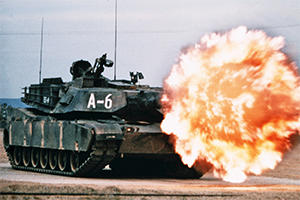100 Years of Excellence: The ATC Story, Part 7
Excerpted from an article by Lauren Nelson
An early test of the M1Abrams Battle Tank.
In 1985, the Materiel Testing Directorate was reorganized as the U.S. Army Combat Systems Test Activity (USACSTA), testing combat weapons, systems and vehicles, other automotive equipment, ammunition components, munitions and general equipment, radioactive environment simulation and research and development programs for test instrumentation, methodology and facility performance requirements. USACSTA's purpose was to test and develop Army materiel, from the Soldier’s uniform to the Main Battle Tank, to ensure the U.S. Soldier would have the best equipment possible on the modern battlefield.
As testing advanced, USACSTA became more environmentally aware, partially because of an incident in the late 1980s. Three senior Chemical Research Development and Engineering Center (CRDEC), employees were tried and convicted on charges of noncompliance with federal environmental laws. As a result, environmental impacts for all testing activities are assessed through the National Environmental Policy Act (NEPA).
In addition, the Noise Abatement Program monitored off-post noise levels and regulated test firing to limit effects on the community. The Chesapeake Bay Protection Program (CBPP) addressed the Spesutie Island Causeway Initiative, which had changed the flow of water along the APG coastline and caused channel sedimentation problems. A dredging project and the addition of culverts were proposed to mitigate sedimentation issues.
CBPP also addressed the test firing operations that had fired into the waters of the Upper Chesapeake Bay since 1917. Quite a collection of munitions exists along the shoreline, especially in the area around Poole’s Island. At the time, it was not feasible to clean up the entire shoreline; the funds did not exist to move 70 years’ worth of munitions buildup, and it would interfere with testing. The long-range artillery work was moved to Yuma Proving Ground.
A major development in the early years of USACSTA, live fire testing is the realistic firing of live rounds of ammunition of all shapes and sizes on vehicles and other systems to search for vulnerabilities. This process was launched into the spotlight with the controversy surrounding the Bradley Fighting Vehicle (BFV), a light, swift-moving troop carrier, in the mid-1980s. The BFV accrued a lot of scrutiny in Washington, D.C., because it was a troop carrier mounted with a large anti-tank weapon system.
In addition, the M1 Abrams tank underwent extensive live fire and vulnerability testing—designers and engineers strived to fulfill the three main design areas: mobility, lethality and survivability. They succeeded in creating a tank that was faster and more maneuverable than earlier tanks and was suitably armored for greater crew protection. The advanced turbine engine provided reliability and quieter operation than the diesel tank engines of the preceding M60 tank series. Through arduous live fire testing at USACSTA, the M1 tank proved to be formidable, and it remains on the mod¬ern battlefield.
The First Gulf War began in August 1990 and immediately boosted testing activity at USACSTA. The BFV proved its worth alongside the M1 tank. The war ended in February 1991, but in that short time, many weapons systems and vehicles tested at USACSTA proved competent in theater.
In December 1991, the Automotive Tilt Table, a hydraulically powered platform device, was completed. This new technology tilted wheeled and tracked vehicles to determine roll and pitch stability under a number of load conditions, in a controlled setting. At Michaelsville, a covered, 300-meter, 60-foot-high firing range completed in March 1992 enhanced small arms weapons testing; the range could house a light combat vehicle for test firing and eliminate delays caused by surface winds and other outdoor adverse weather conditions.
On June 2, 1995, USACSTA became the present day Aberdeen Test Center. In its first year, ATC completed one of its largest projects ever. The Under¬water Explosion Test Facility (UNDEX or UTF) officially opened on July 19, 1995. UNDEX is a large pond, 1,070 feet long by 920 feet wide by 150 feet deep, and is used by the Navy and Army to test underwater explosives without endangering marine life.
The Accelerated Corrosion Test Facility opened on January 6, 1999, at Munson Test Area. Vehicle corrosion testing was combined with durability testing so that the interaction between corrosion and the physical stresses acting upon a vehicle could be ob¬served. A Fire Safety Test Enclosure (the Firebox) was opened later that year. In June 2001, the Bridge Crossing Simulator was officially opened to test fatigue-prone areas of bridging programs. These new facilities allowed tests that formerly took weeks or months to complete to be performed in a much shorter time period.
You are now leaving www.atc.army.mil and entering another site. You will automatically be forwarded to the target page within five seconds.

